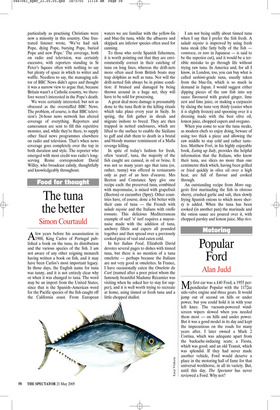The tuna the better
Simon Courtauld
Afew years before his assassination in 1908, King Carlos of Portugal published a book on the tuna, its distribution and the various species of the fish. I am not aware of any other reigning monarch having written a book on fish, and it may have been Carlos’s most important legacy. In those days, the English name for tuna was tunny, and it is not entirely clear why or when it was changed to tuna. The word may be an import from the United States, since that is the Spanish–American word for the Pacific species of the fish caught off the California coast. From European waters we are familiar with the yellow-fin and blue-fin tuna, while the albacore and skipjack are inferior species often used for canning.
To those who revile Spanish fishermen, it is worth pointing out that they are environmentally correct in their catching of tuna on long lines, whereas the drift-nets more often used from British boats may trap dolphins as well as tuna. Nor will the drift-netted fish always be in prime condition: if bruised and damaged by being thrown around in a huge net, they will have to be sold for processing.
A great deal more damage is presumably done to the tuna flesh in the killing rituals which take place every year in Sicily. In spring, the fish gather in shoals and migrate inshore to breed. They are then trapped in netted enclosures, which are lifted to the surface to enable the Sicilians to gaff and club them to death in a brutal and bloody manner reminiscent of a Mafia revenge killing.
In spite of today’s fashion for fresh, often ‘seared’, tuna, the majority of the fish caught are canned, in oil or brine. It was not so many years ago that tuna (or, rather, tunny) was offered in restaurants only as part of an hors d’oeuvre. Mrs Beeton and Constance Spry give one recipe each: the preserved tuna, combined with mayonnaise, is mixed with grapefruit (Beeton) or cucumber (Spry). Other countries have, of course, done a bit better with their cans of tuna — the French with salade niVoise and the Italians with vitello tonnato. This delicious Mediterranean example of surf ’n’ turf requires a mayonnaise made with the addition of tuna, anchovy fillets and capers all pounded together and then spread over a previously cooked piece of veal and eaten cold.
In her Italian Food, Elizabeth David devotes several pages to dishes with tinned tuna, but there is no mention of a tuna omelette — perhaps because the Italians are not very good at omelettes. In France, I have occasionally eaten the Omelette du Curé (named after a poor priest whom the famously beautiful Madame Récamier was visiting when he asked her to stay for supper), and it is well worth trying to recreate at home, using tinned or fresh tuna and a little chopped shallot. I am not being sniffy about tinned tuna when I say that I prefer the fish fresh. A salade niVoise is improved by using fresh tuna steak (the fatty belly of the fish ventresca, or toro in Japanese — is said to be the superior cut), and it would be a terrible mistake to go through life without trying raw tuna. In America and, for all I know, in London, too, you can buy what is called sashimi-grade tuna, usually taken from the blue-fin, which is so much in demand in Japan. I would suggest either dipping pieces of the raw fish into soy sauce flavoured with grated ginger, lime zest and lime juice, or making a carpaccio by slicing the tuna very thinly (easier when it is slightly frozen) and spooning over it a dressing made with the best olive oil, lemon juice, chopped capers and oregano.
When you come to sear the tuna steaks, as modern chefs so enjoy doing, beware of using too thick a piece and allowing the raw middle to stay cold and rather tasteless. Matthew Fort, in his highly enjoyable book, Eating up Italy, provides the helpful information that the Italians, who know their tuna, use slices no more than one centimetre thick which, having been grilled or fried quickly in olive oil over a high heat, are full of flavour and cooked through.
An outstanding recipe from Moro suggests first marinading the fish in oloroso sherry, crushed garlic and salt, then slowly frying Spanish onions to which more sherry is added. When the tuna has been cooked (in another pan) the marinade and the onion sauce are poured over it, with chopped parsley and lemon juice. Muy rico.

























































 Previous page
Previous page